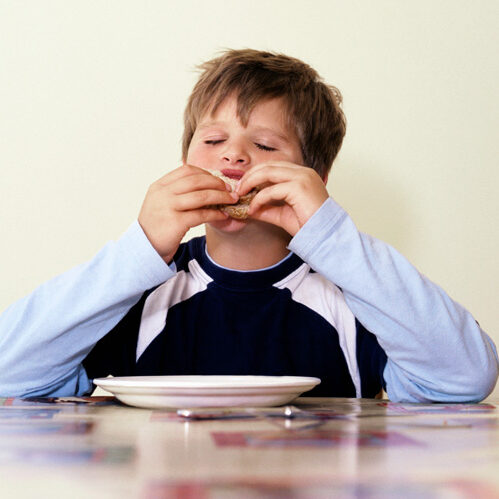My Child Can’t Eat: Part 3

Sensory Challenge Strategies
This article will discuss strategies to help with the child who has sensory challenges. Effective treatment depends on a child's and family’s needs and this article is more for general information.
Treatment for sensory processing problems is called sensory integration. The goal of sensory integration is to challenge a child in a fun, playful way so they can learn to respond appropriately and function more normally. The idea is to help your child get used to things they can't tolerate in a variety of ways, and create opportunities for the body to have input in a manner that is enjoyable and tolerable.
After using the Motivation Assessment Scale or MAS, you have discovered a specific reason that the behavior is happening. As you recall, the areas we are focusing on are: Sensory, Escape Demands, Escape Attention, Attention and Tangible.
Let’s say your child is not eating due to sensory reasons. Sensory, in this case, is best defined as how we as humans we sense our environment with our senses: touch, eyes, nose, ears, body. There is also a movement component.
I explain to parents that we begin building a library of information as relates to our senses from the time we are born. An infant is born nearsighted and sees in black and white. The optimal distance for babies to see is about 12 inches. By about 5 months of age, your child is able to see in 3 dimensions and see in color.
As infants, our first way to “know” and begin learning about our world is through our skin via touch receptors—the most sensitive receptors are in the face, mouth and hands, and this is why infants mouth everything in their first year of life. Infants also are learning about our world through their nose with smell receptors. There are studies that show infants recognize their mother’s smell from birth.
As your baby begins to move about by being on their tummy, rolling, crawling and reaching, a symphony of vision combined with movement really begins expanding on the “touch” library in our brains. The brain has a different understanding of touch with poor or no vision and touch attached with vision. It is really two different experiences to the brain and it is “filed” as two different experiences. It is the way we evolve as humans.
For example, most children who have sensory challenges have significant issues with the way the brain interprets touch information via the touch pathways in our brains. Since the brain is giving or receiving conflicting or inaccurate information via the touch and smell pathways, the child then begins using their vision to make decisions about what they will and will not touch or put in their mouths.
Over time, the child becomes quite selective about the food they are willing to eat—usually (not always) narrowing down to a few crunchy carbohydrates (like Cheerios), some soft chicken nuggets and milk. From the child’s perspective, anything that does not look or taste like the preferred food will be instantly rejected. When encouraged to go outside the comfort zone, the child will have a meltdown, refusal to eat and a cycle begins.
From a sensory perspective, the foods that your child is not eating is a threat and kicks in the fight or flight response. Something about the way the food looks, feels, tastes, smells or even sounds is extremely displeasing. (Some children cannot tolerate the sound of people chewing. ) Your child becomes ever more hyper-vigilant about foods tolerated.
Sensory challenges are typically not restricted to the dining table. Your child might only wear certain textures of clothing, or refuse to wear long sleeved shirts or long pants. Melt-downs and refusals with having hair washed and combed or brushed are common. Additionally, simple grooming like having nails trimmed can be a real challenge.
Sensory challenges can be addressed outside the eating experience, and providing a broad variety of sensory experiences to a sensory sensitive child will, over time, have a positive effect on eating, as tolerance to a wide variety of touch input (and other sensory inputs) over the day improves.
I encourage you to read up about the term tactile defensiveness. There are many resources that address sensory issues in-depth. I really like Angie Voss, OTR’s work. She has great handouts and a fantastic little book you can download for free.
Instead of reinventing the wheel, below are some of Angie’s suggestions about feeding from a sensory perspective. Hopefully, you get a gem or two from the list below.
- Do not force a child to eat anything. Do not insist on having the child touch it or put it in their mouth. Do not bribe with a reward or insist that they take just one bite, this will only back fire on the nervous system in the long run.
- Respect that trying new foods is a multi-sensory experience and that the smell and look of the food may be overwhelming in itself...never mind putting it in the mouth to experience the taste and texture of it all.
- If the child is having an "off" sensory day, then expect the food choices to be even that much more limited...it's OK, each day may be different.
- Try not to talk about food all of the time. It is hard enough for the child as it is. Our society is so preoccupied with food and the child is constantly bombarded with food choices and experiences...all day long.
- If your child has a few balanced food choices, then let it be and let the food choices expand naturally (with a sensory enriched life of course to work on the sensory foundation and sensory processing).
- Offer daily opportunities to play and interact with food, yet in a fun and exploring kind of way. Refrain from even suggesting to "try it" or "taste it". Let it happen naturally.
- Offer daily sensory activities involving the power sensations.
- Offer daily tactile experiences, since the oral sensory system is a part of the overall tactile system.
Right before mealtime prep the nervous system and brain by 15 minutes of vestibular and proprioceptive play. - Prep the oral structures by offering gum or an oral sensory tool prior to mealtime and offer an opportunity for resistive sucking or blowing, such as a bubble mountain.”
I am a big fan of, and highly recommend the concept of Food Chaining. This concept was coined and developed by Cheri Fraker et.al.
What is food chaining?
“Food chaining is a diet based on a child's taste, texture, and temperature preferences,” says Cheri Fraker, a pediatric speech pathologist and co-author of Food Chaining: The Proven 6-Step Plan to Stop Picky Eating, Solve Feeding Problems, and Expand Your Child’s Diet.
The process begins with figuring out what foods your child already likes and gradually offer new foods that are similar to those favorites. "Gentle changes let your child expand their foods without anxiety,” she says, adding that she's seen this double the number of foods a kid will eat.
- First, make a list of your child’s favorite foods—what they are currently eating. This is the “core” diet of your child.
- Next, take your list and add foods in that have a similar taste or texture and offer them to your child as a combo.
- For example, consider different flavors of the same cereal (regular cheerios, honey and nut cheerios, multigrain cheerios).
- For chicken nugget eaters only, add a different brand of chicken nuggets, or a homemade chicken nugget to the plate. They might not eat it at first and it might take 20-30 offerings or presentations for them to accept it.
- “Keep expanding by offering a 'close cousin' to the core-diet foods a few times a week until your child is not afraid of the new food,” says Fraker.
- If your child is verbal, ask them for grades. When your child tries a new food, ask them to grade it on a scale from 1 to 5 with 5 being the best. If a food is 3 or higher, try it again.
- Rethink what's "new." A tiny step can help kids get used to the idea of trying a "new" food.
- If your child only eats cheese pizza, offer a slice of cheese pizza with a different color of cheese added.
- If your child will only eat a certain shape of pasta, see if you can find that pasta shape in different colors or similar but slightly different shapes.
- For a child with eating challenges, any difference in their food is virtually a “new” food.
- Take the pressure off mealtime by adding an unexpected twist.
- Put dry cereal in ice cube trays.
- Let them dip their cereal in milk or yogurt.
- Serve sauces on the side so children can have control of what they dip their favorite food in.
Be patient, practice your breathing and don’t cave in. Offer a range of foods, including foods that are similar and observe the success of eating over the course of a week instead of over a single meal.
If you are not having any success, do consider getting a professional to help you—look for an occupational therapist or speech language pathologist who is trained in eating and feeding disorders. Think about what your kid eats over the course of a week rather than the success of an individual meal.
Useful Resources
I also love the book: The Out-Of-Sync Child by Carol Stock Kranowitz.
Feeding/eating is a complicated subject and a child with significant sensory issues makes that even more challenging. I hope this article has helped you in some way. My next article will discuss behavior interventions in a more general way.
Rosemary Slade, PLLC, OTR, NC is a practicing occupational therapist and mineral-nutritional balancing practitioner. She can be reached on this website. This article is not in any manner, shape or form intended to be considered or construed as medical advice or providing a medical diagnosis. This article is for entertainment purposes only. Please see your medical doctor for medical diagnoses.
